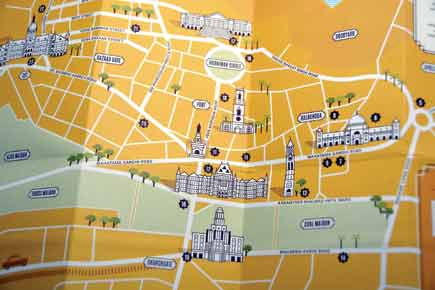Want to explore South Mumbai at any time you want? A new map is the answer to your prayers

 It's the question that leaves you stumped. A tourist (or someone new to Mumbai) asking you: "where can I go to acquaint myself better with the city?" You want to say south Mumbai, but where do they begin?
It's the question that leaves you stumped. A tourist (or someone new to Mumbai) asking you: "where can I go to acquaint myself better with the city?" You want to say south Mumbai, but where do they begin?
ADVERTISEMENT

The route starts from Apollo Bunder and winds through Kala Ghoda, Horniman Circle to end at CST. Pic/Pradeep Dhivar
Now, all you have to do is hand them a R300 worth map of the area that marks an over three-hour route starting from Gateway of India, passing through the Bombay High Court and Horniman Circle and ending at Crawford Market. Building Bombay, a Storycity project by the Bandra-based Kahani Designworks, is an A3-sized mustard-coloured map that folds into an A6-sized paper that you can easily stuff into your purse or book.
"The map lists buildings along this route that are open to the public, and are of some cultural and architectural significance. We haven't included any restaurants or cafés, as this is not about spending money," says Ruchita Madhok, who has created the content for this map along with Sourav Roy.

Ruchita Madhok
The map, which will be available for purchase at museum stores this weekend onwards, has been illustrated by Pragati Jhujhunwala. The map has been divided into five sections — Apollo Bunder, The Kala Ghoda Precinct, The Oval Maidan, The Horniman Circle and CST — in case you don't have the energy or time to attempt it all at one go.
On the need of creating such maps, Madhok says, "We realised that heritage walks are becoming popular in the city. People are, in fact, ready to wake up early on Sunday mornings and be at these spots at 7.30 am. So, we thought of creating a similar map that would allow people to do this walk on their own, and at their own pace," adds Madhok. While the front of the map carries the route, the back details the significance of the listed buildings along with other anecdotes.
For instance, the Flora Fountain was commissioned for the botanical gardens but bought over by the municipality when the original clients ran out of funds? The Horniman Circle garden, Madhok points out, was a garden that was initially part of the original fort i.e. the fort within which the British garrison existed.
The fort, which gives the area its name, was broken down to allow Bombay to expand into a larger city. While the fort walls have since disappeared from the city's architectural map, it still retains its place in history and nomenclature. The map does seem like a visual representation of Fort Walks by Sharada Dwivedi and Rahul Mehrotra. "I have been reading Dwivedi's works on Mumbai as a kid," says Madhok.
There are other maps in the pipeline — a nature map, one on public art, one on street art and one on the city's many statues. So, it might be time to invest in a new pair of walking shoes.
 Subscribe today by clicking the link and stay updated with the latest news!" Click here!
Subscribe today by clicking the link and stay updated with the latest news!" Click here!






